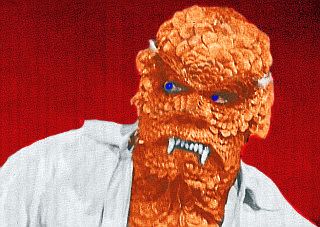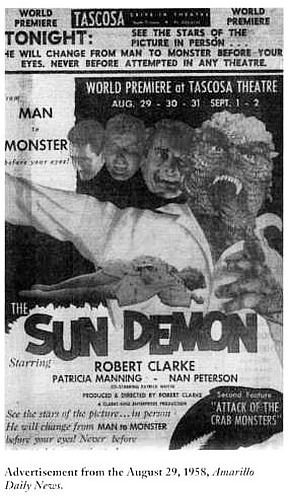Hideous Sun Demon page 1
Hideous Sun Demon page 2
Hideous Sun Demon page 3
Hideous Sun Demon page 4
Hideous Sun Demon page 5
Hideous Sun Demon page 6
Hideous Sun Demon Posters
Hideous Sun Demon Photo Gallery
Hideous Sun Demon Photo Gallery 2
Hideous Sun Demon Items
Hideous Sun Demon Homepage
Hideous Sun Demon Sitemap
The Hideous Sun Demon , the film Clarke is most noted for, also has origins in Clarke's experience in theaters as a boy. As a 12 year old, Clarke had skipped school one day to go to the movie theater and see Dr. Jekyll and Mr. Hyde (1931), starring Fredric March, who received an Oscar for his performance in the title role(s). Clarke was very impressed with both the story and March's performance, and when Clarke (inspired by the profits of The Astounding She Monster) first started thinking about making his own movie, he decided to draw upon story elements from Dr. Jekyll and Mr. Hyde. (The Hideous Sun Demon has a doctor with a dual personality disorder, and two very different women who draw his attention: one very sweet and innocent, the other a street-wise bar singer.) It was from these two very different movie sources, one with an Oscar-winning performance and one on a shoestring budget, that the Hideous Sun Demon would be born.
Determined to do his best, Clarke prepared for the project by taking screenwriting at the University of Southern California. Other students were enthusiastic about the project, and became involved, some offering services and one helping to finance the production. A non-union production, Clarke found aspiring actors for larger roles, and even drew on some non-professionals for smaller parts. A casting call helped find both leading actresses, Patricia Manning and Nan Peterson. Clarke's sizable family of in-laws and circle of friends were pressed into service both in front of and behind the camera, to help save on costs. The family dog Egan, who had his film debut in The Astounding She Monster, makes another appearance in Hideous Sun Demon .
For the Sun Demon costume, Clarke consulted Jack Kevan, who had worked on Creature From The Black Lagoon. However, Kevan's quote of $5,000 was well outside Clarke's budget. Happily, Clarke found Richard Cassarino, who developed a sun demon mask and torso for $500. Cassarino made a plaster cast of Clarke's head, on which he formed the mask. For the torso, scales were applied to the top half of a skin diving suit. It was terribly hot and uncomfortable for Clarke (who performed his own stunts in the movie), working inside a costume while mostly out-of-doors in the “blaze of the sun.” In some scenes Clarke was sweating so profusely that it has soaked through to his pants, and is quite visible on film.
The film's budget started with only $10,000, half contributed by Clarke and half cntributed by USC student Robin Kirkman. Filming began in late 1957. To keep costs low, Clarke shot only on weekends, enabling him to get camera, lighting and sound equipment rentals for a full two days at the cost of one. The entire production phase took only twelve weekends, with Clarke using existing locations as a way to work more quickly and economically. Editing took much longer, but finally the film was finished.
The Sun Demon was first shown at Amarillo's Tascosa Drive-in theater in Texas. The reception to the film was good and Clarke was flown to Dallas to screen the film for the city's Universal Studios Exchange. But Universal Pictures passed on the film, as did Warner Brothers. Possibilities of deals with the major studios had basically crumbled, and Clarke was too leery of AIP (American International Pictures) to sign a distribution deal with them. A friend pointed him to another option: Miller Consolidated Pictures. Two business partners started the company to compete with AIP, and offered to pair The Sun Demon with their first film, A Date With Death. Clarke agreed.
On January 27, 1959, the film --now sporting the title The Hideous Sun Demon -- opened at the bottom of a double bill with A Date With Death at the indoor Plains Theater at Roswell, New Mexico. Clarke appeared on stage in person wearing the sun demon costume (like he had earlier at the Tascosa Drive-in). Thanks to Miller Consolidated's distribution, the Hideous Sun Demon played in many areas in the United States and England. However Clarke never got a penny for his film from the fledgling company because Miller Consolidated went bankrupt soon after the film was distributed.
The Hideous Sun Demon was by no means a great movie, nor was it a groundbreaking movie. However it stands as a fine example of entertaining B-movie fare from the golden days of small movie house and drive-in sci-fi/horror movies. Measured against many of the other films produced during this period on small budgets, and the monster costumes in those movies, the Hideous Sun Demon outshines much of the competition. Although Clarke is generous with credit, a heaping measure must go to him and his determination to make the best and most entertaining movie he could with what he had. The movie was never the moneymaker Clarke had hoped it would be, but for many fans of the B movie genre, the Hideous Sun Demon remains a beloved classic. (Most of the above article and plot were taken from a Creaturescape article about the career of Robert Clarke. Also used excerpts and the movie ad at the top of the page from "A Drive-in Horror by Default, or, the premiere of the Hideous Sun Demon" by author Gary D. Rhodes.)
(Plot taken from Creaturescape and excerpts/images used from Horror at the Drive-In given full credit.)
Disclaimer: Hideous Sun Demon © Wade Williams Productions. No rights given or implied. This independent, non-profit, fan-based analysis of Hideous Sun Demon is © 2007 by William Armstrong and everything on this website (photos, screencaps, text, etc.) should not be used without permission.





